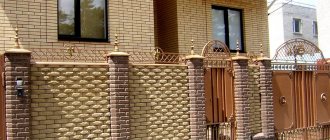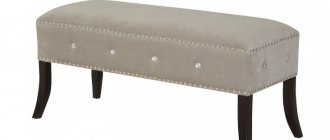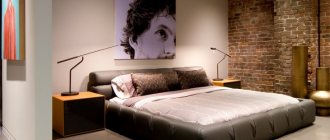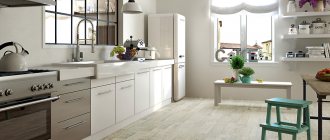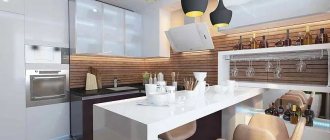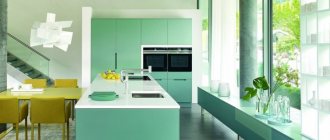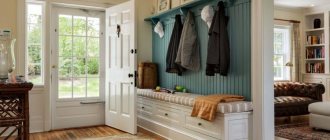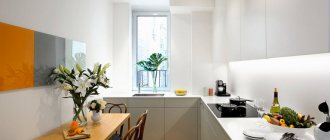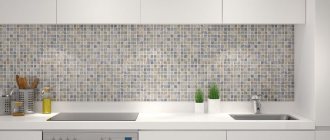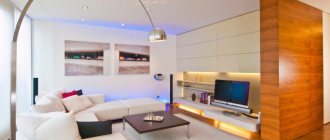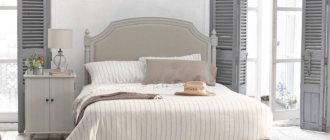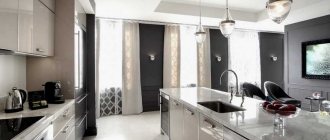Types of facades
Kitchen facades are the visible, front side of the set. Cabinet doors are furniture elements that are included in the overall composition of the kitchen style. They create the appearance of the room.
The kitchen is designed for cooking, so fatty fractions settle on the furniture panels. Increased demands are placed on them. This is not only an aesthetic element, but also resistance to high temperatures, high moisture, splashes of oil and fat.
The type of furniture, strength and price depend on the base material and type of decoration.
Solid wood is a classic style, durability and beauty. Their prices are high.
Laminated chipboard is considered short-lived, but much cheaper than solid wood.
MDF is rightfully recognized as one of the best materials for the manufacture of modern kitchen sets. It is easy to make, durable to use and inexpensive.
The plastic is good to use, beautiful, the gloss does not deteriorate for a long time, but requires constant care (fingerprints remain on the surface).
Photos of kitchen facades are posted on all design sites on the Internet. The facade is the face of the kitchen unit, the beauty and elegance of the entire created interior.
Every family has photo albums that depict family scenes. The love for photography is still strong today, it’s just that everything is much simpler. Everyone without exception takes selfies against the backdrop of nature, landmarks, and even just in the kitchen space.
This, too, will ultimately be history someday. Descendants will consider with interest which façade of kitchen furniture was fashionable in our time.
Note!
Kitchen countertop made of artificial stone: TOP-120 photos of kitchen countertop designs. Ideas for making artificial stoneSofa in the kitchen - pros and cons of sofas in the kitchen. New designs + photo reviews of materials and structures
Railings for the kitchen: TOP 100 unusual solutions in the interior. Features of choosing and installing roof rails in the kitchen
Basic requirements for kitchen facades
The selection of the optimal kitchen facade material should be made taking into account many criteria:
- Resistance to moisture and steam (especially for cabinets located next to the hob).
- Wear resistance (mostly applies to the top layer of the doors, which will be cleaned of dirt).
- Strength of the base (a reliable canvas should not deform over time, otherwise it will be impossible to guarantee a tight fit of the doors; in addition, increased strength will eliminate the problem of the hinges being pulled out of the door after long-term use).
- Easy to maintain (will ensure easy cleaning of the façade from dust, grease and other types of contaminants).
- Durability (depends on the performance characteristics and characteristics of the canvas material itself).
Selection of facades
A kitchen set is the furniture that owners of houses and apartments most often order. Which facades to choose for the kitchen? Which material is more durable and wear-resistant? These questions always torment those who decide to update the kitchen interior, replace the furniture with a stylish and fashionable model.
The beauty and attractiveness of kitchen furniture is determined by the facade. There are a great many design options for furniture facades. It is necessary to choose the most suitable set for your kitchen, taking into account both the appearance and the price factor.
You need to choose the optimal combination of price and quality of the model. Only with this approach will the furniture last you a long time and delight you with its design.
Facade materials - advantages and disadvantages
For the production of kitchen facades, a variety of materials are used: natural wood, MDF, chipboard, glass. Their service life and ease of maintenance directly depend on the manufacturing features of such elements. Also, when selecting facades, do not forget about the characteristics of the base material. The higher its wear resistance, the longer it will retain its original appearance and attractiveness. Veneer, enamel, various films and plastic are used as auxiliary materials for finishing the canvas. Such coatings for the most part have increased resistance to abrasions and mechanical damage. Another important difference between the facades used is their price category. Even short-lived materials with specialized coating or processing can be quite expensive. After studying the description of each type of facade, you will be able to evaluate different types of materials and choose the best one.
Natural wood facades
Wooden facades are produced using complex technology using special equipment. Initially, an array is selected according to its quality and class. Then the wood is dried to prevent its deformation during natural drying in the future. The harvested wood is sawn according to the required parameters. When making frame models, protruding decorative elements (the frame itself, consisting of side parts and a pair of crossbars) are cut out separately. The frame elements are used to cover the main canvas. For protection, treatment is carried out with an antiseptic. If necessary, painting is carried out, and then finishing - coating with varnish, oil or wax. The advantage of wooden facades is maximum service life, good resistance to negative influences, increased strength and wear resistance. For care, gentle household chemicals are used (not abrasive!). Periodic treatment with polish and wax is also recommended.
Veneered facades
For the manufacture of veneered facades, MDF or chipboard is used as a base. The canvas is covered with a thin layer of wood (veneer) by gluing. After drying, the sidewalls of the canvas are glued with a special edge (in the event that the veneer itself was not glued to all the sidewalls). Additionally, the façade is varnished. Thanks to the use of thin wood materials, the finished product is very similar to its natural wood counterparts. But at the same time, its price is affordable for many buyers. The only drawback can be considered the multilayer nature of such a facade, which does not guarantee its long service life and preservation of appearance. Therefore, you need to order veneered facades only from trusted manufacturers who comply with all production technology.
Glass facades
Furniture facades made of glass are divided into two types: framed and frameless. The first ones are framed with an aluminum frame or enclosed in a frame made of wood or MDF. They are most popular due to the reliable protection of the entire perimeter of the canvas. The second ones are completely glass. They require special processing of the edges, which eliminates the risk of injury upon contact with the sides, top or bottom. The following types of glass are used in production:
- laminated: “assembled” from two or more layers by connecting them when exposed to high temperatures, has increased strength, and is additionally framed;
- hardened: produced under the influence of high temperatures, suitable for all types of facades, when broken it crumbles into non-sharp fragments;
- float glass (regular): made from glass melt exposed to high temperatures, has minimal impact resistance, most often used for framed facades (with or without dividers between pieces of glass).
MDF facades with enamel coating
Glossy enamel facades look great in any kitchen. The rich colors of the coating combined with its attractive presentation provide harmony to the interior. True, the production technology of such products is multi-stage and requires a professional approach. To make a high-quality facade with enamel, manufacturers carry out the following operations:
- Prepare the base (MDF canvas) for painting by priming.
- Enamel paint is applied in several layers. Aerosol spraying must be carried out using special equipment. Each layer is completely dried.
- An additional protective coating is applied (usually varnish).
The advantage of enamel products is their long service life and bright color throughout their entire service life.
The compositions used do not have an unpleasant odor. The disadvantages include the difficulty of maintenance: fingerprints and dirt are clearly visible on the glossy surface. For care, only soft sponges and gel household chemicals are used.
PVC coated facades
Coating the MDF canvas with PVC film guarantees its additional protection from moisture and mechanical damage. The production technology of such elements includes the following stages:
- Cutting slabs according to specified parameters. Processing edges, milling patterns if necessary.
- Sanding and cleaning the canvas.
- Applying hot glue in several layers, drying the product.
- Gluing PVC film using a thermo-vacuum press.
- Removing excess film.
Thanks to this production, the film is guaranteed to fit tightly to the base (regardless of the presence of filigree elements). The film itself will not peel off from the base when exposed to steam or high temperatures. Gentle household chemicals are used to clean the finished façade. If it is necessary to update the facade (taking into account the integrity of the base), a new film can be used. This guarantees cost-effective restoration of products.
MDF facades and plastic finishing - postforming
MDF facades can have not only a film or enamel coating, but also be protected with plastic. The manufacturing technology is short, but at the same time it allows you to achieve high-quality protection of the base and give it an original look. The work is carried out in three stages:
- Application of kraft paper to MDF to increase adhesion between the base and the plastic.
- Connecting the plastic layer with the prepared base.
- Application of a protective layer of melamine and acrylic resins.
The advantages of the products include ease of maintenance and the ability to clean the surface with fine abrasive compounds. The high cost is considered a serious disadvantage.
Postforming facades can be plain or complemented with patterns. Such models are ideal for non-standard kitchen styling.
Laminated facades
In the manufacture of furniture facades, laminated MDF and chipboards (LDSP) are often used. The production of materials is carried out according to the following scheme:
- Applying primer and drying the slab.
- Application of 1 to 3 layers of special paper impregnated with resins to improve the adhesion of the base to the film. The procedure for combining MDF or chipboard with paper is carried out by pressing at high temperatures.
- Application of thick transparent paper: during the process of heating and pressing, it becomes a reliable film.
Thanks to this production technology, laminated facades have increased resistance to mechanical damage, fading, and moisture. To clean them, the use of fine abrasive chemicals is allowed. Over time, the applied film will not peel off, which makes them durable. The disadvantages include the high cost.
Facades with acrylic coating
Acrylic-coated facades can be classified as a type of plastic product. The process of their production is quite similar: MDF or chipboard is used as a base, a thin sheet of acrylic is glued to it on top and the workpiece is pressed. Additionally, the sidewalls are covered with acrylic edges. Due to the significant thickness of the decorative layer, the finished facades look quite thick. In this case, the application can be either unilateral or bilateral. The second option allows you to get a façade that has the same design on the front and back sides. Beautiful acrylic facades have a rich color and shine brightly in natural and artificial light. Another advantage of the products is resistance to moisture and fading in the sun. The disadvantages include the need for constant maintenance with gentle gel chemicals: on glossy surfaces any dirt is clearly visible.
Frame facades based on MDF profiles
In the manufacture of framed facades, two main parts of the product are used: the frame and the inner panel. If the frame itself consists of upper and lower crossbars and 2 sidewalls, then the filling can be made in different design variations. For example, glass, MDF canvas, grilles, and blinds can be installed in the frame. During the manufacturing process, a recess (groove) is cut inside the profile, where the blade will be installed. The frame components are fastened together with special brackets. The angle between the individual frame elements is 45 degrees. The advantage of this type of facade is its attractiveness and the ability to implement non-standard designs. Serious disadvantages include the difficulty of care. If there is glass, the owners will have to wash the frame separately and separately remove dust and dirt from the glass. The frames themselves are cleaned using only gentle chemicals.
Facades with aluminum frames
The presence of an aluminum edge guarantees reliable protection of the sidewalls of the canvas. Unlike conventional film, aluminum frames are resistant to mechanical damage and can be easily cleaned with fine abrasive compounds. When producing this type of facade, MDF or glass sheet is enclosed in an aluminum edge, which has a U-shaped profile. Thus, on the facade itself (along the perimeter of the doors) there will be an aluminum strip. The advantage of this type of product is reliability and durability. They will ideally complement kitchens decorated in modern or high-tech style. They can be used both on regular MDF panels and on panels covered with veneer or plastic (glossy or matte). Such facades will not have to be updated in the near future thanks to the additional protection of the aluminum edge. The price category of doors with aluminum frames is average.
Wooden facades
Modern solid wood kitchen facades are still in demand today. The abundance of artificial materials cannot displace them from everyday life. Wooden facades, as a rule, are richly decorated with carvings and varnished. This good quality furniture emphasizes the status of the kitchen and the owners of the house themselves.
Interiors in the classic style require just such expensive furniture.
Note!
Modular kitchens: reviews of new designs. Options for furniture arrangement in the kitchen + 160 photo examples- Kitchen set - TOP-150 photos with options for installing a kitchen set. Varieties of furniture placement + design ideas
- Kitchen doors - reviews of types of kitchen doors. Varieties of manufacturing materials. Design ideas with photo examples
Different types of wood are used for manufacturing: pine, beech, ash, oak, alder and much more. Each type of wood has its own advantages and disadvantages, which must be taken into account when producing kitchen furniture from them.
Which material should you prefer?
Currently, kitchen furniture manufacturers produce a wide range of facades.
You need to take their choice very seriously, because the front part of the furniture is the face of your kitchen.
For people who want to save money, chipboard front panels are a good solution.
This allows you to achieve good quality at an affordable price.
To understand which facades to choose for the kitchen, you first need to decide on their material.
For the production of kitchen facades the following are most often used:
The most common material for front panels is chipboard.
Currently, furniture makers use chipboard, which has good density and moisture resistance, which makes it possible to use it in conditions of high humidity.
Making kitchen facades from MDF is a modern and practical solution.
It is made from shavings and dust, which are glued together using urea resins.
The special technology used in the manufacture of MDF provides higher density characteristics and resistance to deformation.
Kitchen facades made of solid wood are very high quality, but expensive today.
Before using wood for furniture production, it is treated with an antiseptic.
- Cocoon chairs
- Double-wall corrugated pipes
- Road rollers
This provides reliable protection against temperature changes and humidity.
Read here! Table setting and decoration for Valentine's Day
Plastic kitchen facades look very modern and are very popular among buyers today.
Plastic allows us to produce original furniture of various textures and colors.
Front panels for kitchen furniture can also be made of veneer, metal and other materials.
Replacement of facades
If the furniture purchased by the owners fits perfectly into the kitchen in size, and there is no money to buy a new set yet, but you want to create a new style, then replacing the kitchen facades will be the most correct decision. This is a less expensive option for changing the design.
Even the most ideal furniture eventually breaks down and requires replacement.
By replacing furniture doors and choosing expensive, beautiful fittings, you can radically change the appearance of not only the furniture, but also create a new style for the kitchen interior.
Rules of care
Even if the family budget does not have enough money to buy kitchen furniture with expensive and high-quality facades, this does not mean that a cheap set cannot serve you for a long time. With proper care, even the most unreliable doors will retain their attractive appearance for many years.
When installing wall-mounted modules above a stove or sink, follow the recommended height to protect the façade from excess humidity and temperature.
Don't forget to check the seals of the built-in oven - they are responsible for protecting your furniture from hot air. Choose detergents in accordance with the type of facade coating to avoid damaging them with too aggressive compounds, and during general cleaning, do not use abrasives or sharp objects to clean the doors from dirt.
We told you what facades are on sale and how they behave in the kitchen. All you have to do is count the cash in your wallet and decide on the design. After this, you can easily choose doors for your furniture that will become its real decoration.
Corner facade
A corner kitchen is the most convenient and comfortable option for placing furniture in a kitchen of any size and style. The working surface of such furniture is quite extensive, which is important for the convenience of cooking.
The corner facade of the kitchen is replete with types, shapes, and color schemes.
A stylish version of a set with a monolithic sink, with shaker-style facades, looks very impressive. The apron chosen in blue is unusually organic with the chocolate-colored tabletop. This is the trend of the season. Lovers of modern style will appreciate this design.
Fittings – types of opening of facades
According to the specifics of the facade itself and the compartment hidden behind it, all fittings used for kitchens can be divided into the following groups:
- spring lifts and microlifts: used to lift doors, while the gas lift ensures their smoothest raising and lowering;
- overhead hinges: used for single-door bedside tables, they ensure neat placement of the sash on the end;
- semi-overlay: used for double-leaf cabinets, in which two doors are placed on one end at once;
- double-leaf hinges: simple fittings consisting of two plates connected by a pin;
- transformable hinges: ensure the door swings open 170 degrees;
- secret hinge: consists of two parts (a cylinder or plates with protruding parts), which, when closing the sash, fit into each other, ensuring a tight fit of the door to the end;
- guides: used to pull out drawers; the best models are those with closers that ensure the drawer slides out smoothly.
Special attention should be paid to overhead handles. They can be in the form of a bracket (classic version), a cylinder (rails), a drop, a ring or a button (protrudes above the door). There are also mortise handles, which are recesses in the facade itself.
Facade dimensions
When ordering furniture, it is designed and manufactured according to the individual tastes of the owners, but with the obligatory consideration of the kitchen space.
The dimensions of kitchen facades should take into account the dimensions of the cabinets included in the set. The dimensions of the shelves inside the cabinets, the thickness of the walls of the supporting structure, the possible load on the shelves, and other measurements must be carefully measured and calculated. This should not be done by customers, but by measuring specialists, together with model designers.
Which kitchen fronts are still better?
From all of the above, the only correct conclusion can be drawn - you need to choose facades for the kitchen consciously and, at least, with minimal knowledge about each of the options. Affordability in price does not always play a major role, and if you want to buy furniture that will please the eye for many years and at the same time be safe, then you should not skimp or rush to buy the first model that is suitable for the price. It is better to postpone the purchase for a while and buy a kitchen set made of solid wood, which will last for centuries and will never go out of fashion, than in 5-10 years again wonder about buying new furniture.
Plastic facades
Kitchen plastic facades are in great demand among buyers. Plastic kitchen facades are durable, practical and beautiful.
They fit perfectly into the style of minimalism, modern classics. The design of these styles is distinguished by the clarity and geometry of lines and laconic execution.
The plastic of the facade is stylized like wood, like leather, and made glossy.
The plastic is resistant to chipping, which is important, considering that in the kitchen they deal not only with dishes, but also with large kitchen utensils.
Such a wide range of offers makes plastic facades popular and in demand.
Laminated facade
A laminated kitchen facade will be an equally fashionable addition to your interior. The glossy surface and a huge selection of colors will allow you to create a fashionable kitchen in a modern style.
But you should also think about the fact that such a stylish kitchen will not be easy to call practical - any stains will be noticeable on the mirror surface, you need to especially often monitor the cleanliness of the set.
Manufacturing of facades
The kitchen is a room where cooking contributes to increased humidity, pollution and temperature changes. The choice of facades must be approached thoughtfully and carefully.
It is best to entrust the production of kitchen facades to specialists or furniture workshops. They will take into account all the nuances, tell you what type of furniture will suit the kitchen layout and fit better into the interior.
The measurements of professionals will be clear, and the project calculations will take into account all the loads on the furniture. Surprises with premature failure of furniture can be avoided.
Using knowledge gained from the Internet, as well as recommendations from designers and furniture manufacturing specialists, you can select options for kitchen facades that will help create a unique atmosphere of warmth, coziness and comfort in your kitchen.
Advice from professionals: what to consider when choosing a facade
- You should choose one or another type of facade based on the style orientation of the room: if wooden facades are appropriate for a kitchen in the Provence style, then for high-tech you should opt for enamel-coated MDF facades.
- Film-coated facades allow you not only to choose the ideal tone for the kitchen, but also to choose a pattern or texture (for example, wood or marble).
- Lovers of natural materials should pay attention to natural wood veneer, which is not only a more affordable option compared to solid wood, but also much more environmentally friendly.
- Frame facades should be used with maximum decorative effect, combining different colors and textures.
- If you want to decorate your kitchen with curved facades, you should first of all focus on choosing the appropriate option from MDF, veneer or solid wood.
